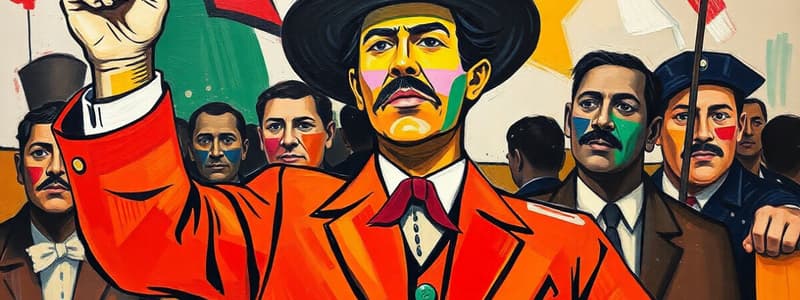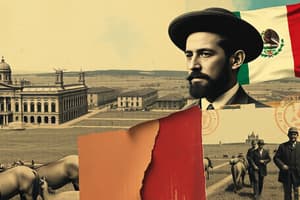Podcast
Questions and Answers
What did Cárdenas's foreign minister do to help further cultural diplomacy?
What did Cárdenas's foreign minister do to help further cultural diplomacy?
- He organized cultural exchanges of art, music, and sports across the Americas and the world. (correct)
- He signed treaties with other American countries to promote cultural exchange.
- He funded art programs in schools.
- He implemented policies that promoted cultural exchange.
Why did Cárdenas change the structure of the PNR?
Why did Cárdenas change the structure of the PNR?
- He wanted to establish a more centralized government.
- He wanted to create a more inclusive party that represented all sectors of society. (correct)
- He wanted to increase the power of the military.
- He wanted to weaken the influence of the Catholic Church.
What was the main goal of the PRM?
What was the main goal of the PRM?
- To promote economic development.
- To increase the power of the church.
- To protect the interests of the wealthy elite.
- To serve as the ultimate arbiter of social conflicts. (correct)
Which of the following groups opposed Cárdenas's policies?
Which of the following groups opposed Cárdenas's policies?
Why did the Partido de Acción Nacional (PAN) form?
Why did the Partido de Acción Nacional (PAN) form?
Which of the following statements accurately describes the outcome of the ejido program during the Cárdenas years?
Which of the following statements accurately describes the outcome of the ejido program during the Cárdenas years?
What was the primary reason for the decline in cotton production in the Laguna region during the Cárdenas years?
What was the primary reason for the decline in cotton production in the Laguna region during the Cárdenas years?
Which of the following factors contributed to the success of the land reform program in some areas during the Cárdenas years?
Which of the following factors contributed to the success of the land reform program in some areas during the Cárdenas years?
How did life in rural Mexico change as a result of the land reform program?
How did life in rural Mexico change as a result of the land reform program?
What was the primary objective of the ejido program, as stated in the text?
What was the primary objective of the ejido program, as stated in the text?
What specific land use was characteristic of the Laguna cotton ejido?
What specific land use was characteristic of the Laguna cotton ejido?
What was the main reason for the establishment of the Banco de Crédito Ejidal by the government?
What was the main reason for the establishment of the Banco de Crédito Ejidal by the government?
Which of the following best describes the impact of the land redistribution program on Mexico's rural zones by the end of Cárdenas' term?
Which of the following best describes the impact of the land redistribution program on Mexico's rural zones by the end of Cárdenas' term?
What was a significant paradox associated with the Laguna ejido's long-term development?
What was a significant paradox associated with the Laguna ejido's long-term development?
Why did the government establish schools, social services, and a hospital in the Laguna ejido region?
Why did the government establish schools, social services, and a hospital in the Laguna ejido region?
Flashcards
Ejido
Ejido
A communal land system in Mexico for agricultural use.
Banco de Crédito Ejidal
Banco de Crédito Ejidal
An agrarian bank that provided loans to ejidos.
Cárdenas' land reform program
Cárdenas' land reform program
Aimed at redistributing land to empower campesinos in Mexico.
Campesino leagues
Campesino leagues
Signup and view all the flashcards
Hacienda complex
Hacienda complex
Signup and view all the flashcards
Land Redistribution
Land Redistribution
Signup and view all the flashcards
Cárdenas' Achievements
Cárdenas' Achievements
Signup and view all the flashcards
Laguna Cotton Ejido
Laguna Cotton Ejido
Signup and view all the flashcards
Cultural Diplomacy
Cultural Diplomacy
Signup and view all the flashcards
Nationalism in Mexico
Nationalism in Mexico
Signup and view all the flashcards
Partido Revolucionario Mexicano (PRM)
Partido Revolucionario Mexicano (PRM)
Signup and view all the flashcards
Economic Nationalism
Economic Nationalism
Signup and view all the flashcards
Partido de Acción Nacional (PAN)
Partido de Acción Nacional (PAN)
Signup and view all the flashcards
Study Notes
Cárdenas and the Revolution
- Cárdenas' election in 1934 was a significant moment for Mexicans seeking progress in the revolution.
- His career exemplifies the rapid rise through military ranks, culminating in Brigadier General.
- Cárdenas was known as a methodical, principled civilian leader.
- He possessed charismatic appeal and inspired passionate support, but also strong opposition.
- Cárdenas' governorship in Michoacán (1928-1932) showcased his approach.
- He engaged actively with the people to make policy, not relying purely on advisors.
- Educational reforms were a priority, including new schools and prompt teacher salaries.
- Labor and campesino (farming community) organization were also promoted.
- Cárdenas initiated a modest land redistribution.
- Calles supported Cárdenas for president in 1934.
- Cárdenas immediately departed from tradition, refusing to move into the presidential mansion and cutting his salary.
- Cárdenas's administration faced opposition from powerful business, religious, and landowning interests.
- Local leaders (caciques) and converts from the Callismo movement also resisted.
- The president sometimes had to compromise with local elites to implement radical changes.
- Example of conflict: the rebellion of the caudillo Saturino Cedillo.
Domestic Reforms
- Agrarian reform was a dominant focus.
- Land redistribution had a more symbolic effect on rural areas initially.
- Cárdenas distributed 49 million acres of land, surpassing predecessors.
- Communal ejidos (collective farms) were common beneficiaries of redistribution.
- Example: the large Laguna cotton ejido, focused on cotton, wheat, and maize cultivation.
- Government-supported infrastructure: schools, social services, and a hospital were erected in the Laguna region.
- This program faced challenges, including rapid population growth and funding issues.
- Agrarian bank (Banco de Crédito Ejidal) offered loans.
- Criticisms noted limited individual ownership and the failure to address sizable cattle haciendas.
- The impact of the program varied regionally.
Domestic Reforms (Continued)
- Education: The administration emphasized public education, but not always with complete success.
- More Mexicans learned to read and write, but population growth outpaced the funds available.
- Educational efforts included promoting nationalism in art and literature, such as the mural movement.
- Social programs for women and children were also expanded in part to combat the power of the church.
- The government supported women's organizations, particularly in rural areas.
- Catholic resistance to some programs remained a key factor.
Nationalization of Oil
- Cárdenas nationalized seventeen oil companies in 1938, creating PEMEX.
- Dispute began with a workers' strike for higher wages and better working conditions at foreign-owned oil companies.
- Arbitration board ordered wage increases, but companies disregarded the ruling.
- The move faced significant opposition from the U.S.
- Diplomatic resolution: a compromise was reached, and Mexico paid compensation to the companies.
Change in Orientation
- Shorty after the oil expropriation, Calles's party (PNR) was reorganized into the Partido Revolucionario Mexicano (PRM).
- This signified a shift towards a more corporatist state structure, bringing in military and other social sectors within the government.
- Efforts were made to include diverse social groups under the Party's umbrella.
World War II
- World War II had a profound influence on Mexico.
- Initially, the Mexican government attempted to avoid direct involvement.
- German actions escalated the situation, and Mexico broke diplomatic ties with the Axis powers.
- Wartime alliances with the U.S. and cooperation in supply were key factors.
- Mexico granted refuge to Spanish refugees.
- Mexican workers, known as braceros, were recruited for agricultural labor in the United States.
- The war indirectly impacted socioeconomic realities such as increased industrialization in Mexico.
Studying That Suits You
Use AI to generate personalized quizzes and flashcards to suit your learning preferences.




